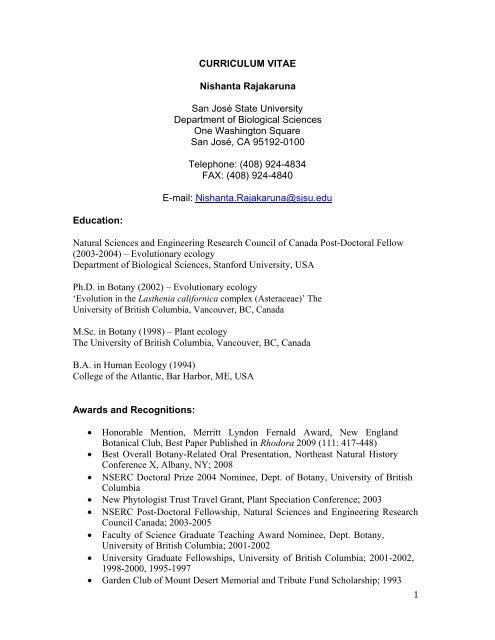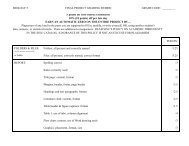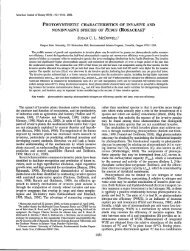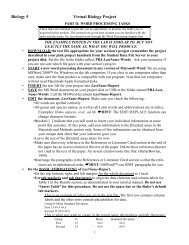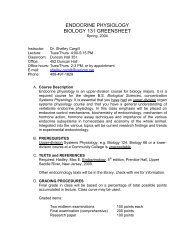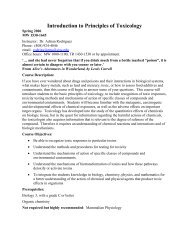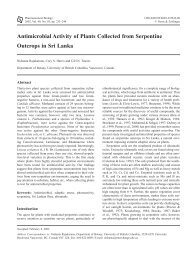CURRICULUM VITAE Nishanta Rajakaruna - Biological Sciences ...
CURRICULUM VITAE Nishanta Rajakaruna - Biological Sciences ...
CURRICULUM VITAE Nishanta Rajakaruna - Biological Sciences ...
You also want an ePaper? Increase the reach of your titles
YUMPU automatically turns print PDFs into web optimized ePapers that Google loves.
<strong>CURRICULUM</strong> <strong>VITAE</strong><strong>Nishanta</strong> <strong>Rajakaruna</strong>San José State UniversityDepartment of <strong>Biological</strong> <strong>Sciences</strong>One Washington SquareSan José, CA 95192-0100Telephone: (408) 924-4834FAX: (408) 924-4840E-mail: <strong>Nishanta</strong>.<strong>Rajakaruna</strong>@sjsu.eduEducation:Natural <strong>Sciences</strong> and Engineering Research Council of Canada Post-Doctoral Fellow(2003-2004) – Evolutionary ecologyDepartment of <strong>Biological</strong> <strong>Sciences</strong>, Stanford University, USAPh.D. in Botany (2002) – Evolutionary ecology‘Evolution in the Lasthenia californica complex (Asteraceae)’ TheUniversity of British Columbia, Vancouver, BC, CanadaM.Sc. in Botany (1998) – Plant ecologyThe University of British Columbia, Vancouver, BC, CanadaB.A. in Human Ecology (1994)College of the Atlantic, Bar Harbor, ME, USAAwards and Recognitions: Honorable Mention, Merritt Lyndon Fernald Award, New EnglandBotanical Club, Best Paper Published in Rhodora 2009 (111: 417-448) Best Overall Botany-Related Oral Presentation, Northeast Natural HistoryConference X, Albany, NY; 2008 NSERC Doctoral Prize 2004 Nominee, Dept. of Botany, University of BritishColumbia New Phytologist Trust Travel Grant, Plant Speciation Conference; 2003 NSERC Post-Doctoral Fellowship, Natural <strong>Sciences</strong> and Engineering ResearchCouncil Canada; 2003-2005 Faculty of Science Graduate Teaching Award Nominee, Dept. Botany,University of British Columbia; 2001-2002 University Graduate Fellowships, University of British Columbia; 2001-2002,1998-2000, 1995-1997 Garden Club of Mount Desert Memorial and Tribute Fund Scholarship; 1993 1
International Student Scholarship, College of the Atlantic; 1990-1994 Professional Experience:Professor of Botany, College of the Atlantic, Bar Harbor, ME, USA (September2010-)Adjunct Associate Professor in Plant Biology, Department of <strong>Biological</strong><strong>Sciences</strong>, San José State University, San Jose, CA, USA (August 2010-)Assistant Professor in Plant Biology, Department of <strong>Biological</strong> <strong>Sciences</strong>, SanJosé State University, San Jose, CA, USA (August 2008-August 2010) Director of the Carl W. Sharsmith Herbarium, Department of <strong>Biological</strong><strong>Sciences</strong>, San José State University, San José, CA, USA (Fall 2008-August2010) Professor of Botany, College of the Atlantic, Bar Harbor, ME, USA(September 2004-June 2008) Visiting Research/Teaching Appointments:Adjunct Faculty member in Botany, College of the Atlantic, Bar Harbor, ME,USA (September 2008-August 2010)Visiting Scientist, Laboratory of Dr. M. C. M. Iqbal, Institute of FundamentalStudies, Kandy, Sri Lanka (09/05-08/08)Research Grants: National Science Foundation (2010)“Collaborative Research: Harnessing the power of herbaria to understand the changingflora of California: A biodiversity hotspot in peril”Principal Investigator for San José State University: N. <strong>Rajakaruna</strong>. $55,490 California Environmental Protection Agency (2009)“Race, ethnicity, and exposure to heavy metals by urban gardeners.”Principal Investigator: O’Malley, R.; Research Assistant: J. Gorospe; TechnicalAdvisors: N. <strong>Rajakaruna</strong> and M. McGowan. $19,343 Stanley Smith Horticultural Trust, California Academy of <strong>Sciences</strong> (2009)“California endemics in an urban garden: developing an internship program in usingCalifornia native plants in horticulture.” Principal Investigators: Lambrecht, S., <strong>Rajakaruna</strong>, N. and J. Cross. $19,9002
Maine Space Grant Consortium Seed Research Grant (2009)“Effect of a catastrophic storm surge on the guano-tolerant plant community of Mt.Desert Rock” Principal Investigators: Anderson, J. and N. <strong>Rajakaruna</strong>. $5000 National Science Foundation (2009)Research to be conducted with undergraduate students: “Is postfire recruitment ofchaparral shrubs constrained by local adaptation to soils (serpentine vs sandstone) ormicroclimates (north vs south slopes)?” Principal Investigator: <strong>Rajakaruna</strong>, N. $30,000 US Forest Service, Region 5 (2009)Research to be conducted with 1-2 graduate and 2 undergraduate students:“Conservation Biology and Fire Ecology of Rare Serpentine Plants of Plumas NationalForest, California.” $404, 800.Principle Investigators: <strong>Rajakaruna</strong>, N. and S. P. Harrison (University of California,Davis). Junior Faculty Career Development Grant, San José State University (2009)Research to be conducted with a graduate and two undergraduate students:“Evolutionary ecology of Lasthenia californica (Asteraceae).” $1500 California State University Research Fund Grant (2008) Research to be conducted with a graduate and two undergraduate students: “Impacts ofmultiple nutrient element enrichment on native and alien plant species in California’sserpentine grasslands: Implications for better management of a threatened habitat.” $7500 Maine Space Grant Consortium Research Fellowship (2006)Research to be conducted with undergraduate students: “Geobotany of Maine:exploring plant-soil relations on extreme geoedaphic habitats.” $5000 Maine Space Grant Consortium Research Fellowship (2006)Grant to conduct a 2-day workshop on plants that grow on heavy metal-rich soils. $2500 Maine Space Grant Consortium Research Fellowship (2006)Research to be conducted with Tanner Harris (Senior, College of the Atlantic) on"Screening for Metal Tolerance in Lichens and Higher Plants from Mine Spoil." $5000 National Park Service: LL Bean Acadia Research Fellowship (2006)Grant to conduct research titled "Conservation Biology of Rare Plants of AcadiaNational Park: A proposal to conduct ecological and physiological studies to betterinform rare plant monitoring and management protocols." $5000 National Park Service (2006)Grant to conduct research titled "Assessment of natural resources andwatershed conditions in and adjacent to Acadia National Park." $49, 9873
Principal Investigators: P. Vaux (U of Maine), S. Nelson (U of Maine), N.<strong>Rajakaruna</strong> (College of the Atlantic), J. Peckenhem (U of Maine), K. Bell (U ofMaine), G. Mittlehauser (Humboldt Field Research Institute), B. Kopp (USGS) Maine Space Grant Consortium EPSCoR Collaborate Seed Grant Program (2005)Grant to conduct research titled “Extremophile Botany: Evolutionary and applied ecology ofplants on heavy metal-rich, extreme soils of Hancock County, Maine.” $17,000 Maine Sea Grant Program Development Fund (2005) Grant to conduct research titled “Metalliferous Plants of the Callahan Mine: PlantDiversity, Heavy Metal Tolerance, and Potential for Phytoremediation.” $5600 Maine Space Grant Consortium Research Fellowship (2005)Research to be conducted with Kathleen Tompkins (Freshman, College of the Atlantic) onthe Physiology, Evolution and Applied Ecology of Plants on Metal-Rich Soils. $2500 Maine Space Grant Consortium Research Fellowship (2005)Research to be conducted with Andrew Thrall (Junior, College of the Atlantic)on Geobotanical Explorations on Metal-Rich Extreme Soils. $2500 National Science and Engineering Research Council (NSERC) CanadaPost-Doctoral Research Fellowship (2003-2004)“Community assembly on serpentine chaparral in California.” $70,000Additional Teaching Experience:Instructor: Summer Courses for K-12 Teachers, College of the Atlantic, BarHarbor, Maine. Course: Field Botany (July 13-26, 2008)Instructor: Summer Courses for K-12 Teachers, College of the Atlantic, BarHarbor, Maine. Course: Woody Plants of Mount Desert Island. (July 9-22, 2006)Instructor: From Cell to System, a Collaborative Science Learning Initiative for 6-12Teachers, College of the Atlantic, Bar Harbor, Maine. Workshop title: Plants onmetal-rich soils. (August 23-25, 2005)Instructor: Downeast Senior College, University College at Ellsworth. Course:Botanical Hikes, Trees in the Four Seasons. A field botany course aimed at teachingtrees and shrubs of Maine to senior citizens. (2004-2005, twice a month)Teaching Assistant: Departments of Botany & Soil Science, University of BritishColumbia, Canada. Courses: Seed Plant Taxonomy, Introduction to Vascular Plants,Plants and People, Introduction to Soil Science. Supervisors: Shona Ellis (Botany),Maja Krzic (Soil Science) 1996-2002; 15 hrs. per week4
Teaching Assistant in Geobotany: Siskiyou Field Institute, Cave Junction, Oregon,USA. Supervisors: A. R. Kruckeberg (Univ. of Washington), R. G. Coleman (StanfordUniversity). 06/99; 1 week, full-timeRelevant Work Experience:Botanical Consultant: Pottinger & Gaherty Environmental Consultants Ltd.,Vancouver, Canada. Risk assessment study of copper mine tailings. 02/00-04/00; parttimeBiodiversity Consultant: Sinharaja Village Trust, Sinharaja Rainforest, SriLanka. Conservation and ecodevelopment. 12/98-04/99; full-timeResearch Assistant in Plant Eco-Physiology: Department of Organismicand Evolutionary Biology, Harvard University, MA, USA. 94-95; full-timeBotanist: Acadia National Park, Bar Harbor, ME, USA. Updated field information onrare and endangered plants of Mount Desert Island. 06-08/93; full-timeAssistant Field Coordinator: Sinharaja Rainforest, Sri Lanka. Established a 25-hectare forest dynamics plot for the Center for Tropical Forest Science, SmithsonianTropical Research Institute (STRI). 08/93-01/94; full-timePeer-Reviewed Publications:<strong>Rajakaruna</strong>, N., T. B. Harris, S. J. Nelson, and P. D. Vaux. 2010. An Assessment ofStressors and Threats to the Flora of Acadia National Park, Maine, USA. Intended for:RhodoraAnacker, B. L., N. <strong>Rajakaruna</strong>, D. D. Ackerly, S. P. Harrison, and J. E. Keeley. 2010.Post-fire regeneration strategy, specific leaf area, and habitat specialization in Californiachaparral. Intended for: Journal of EcologyCiccotelli, B., T. B. Harris, B. Connery, and N. <strong>Rajakaruna</strong>. 2010. The Vernal Pool Floraof Acadia National Park, Mount Desert Island, Maine, USA. Rhodora (accepted pendingrevision)<strong>Rajakaruna</strong>, N., T. B. Harris, S. Clayden, A. Dibble, and F. S. Olday. 2010. Lichens ofCallahan Mine, a Copper and Zinc enriched superfund site in Brooksville, Maine, U.S.A.Rhodora (in press)Pope, N., T. B. Harris, and N. <strong>Rajakaruna</strong>. 2010. Vascular plants of adjacent serpentineand granite outcrops on the Deer Isles, Maine, USA (Rhodora 112; in press).<strong>Rajakaruna</strong>, N., N. Pope, J. Perez-Orozco, and T. B. Harris. 2009.5
Ornithocoprophilous Plants of Mount Desert Rock, a Remote Bird-Nesting Island inthe Gulf of Maine, USA. Rhodora 111: 417-448.R. S. Boyd, Kruckeberg, A. R. and N. <strong>Rajakaruna</strong>. 2009. Biology of ultramafic rocksand soils: research goals for the future. Northeastern Naturalist 16: 422-440.N. <strong>Rajakaruna</strong> and R. S. Boyd. 2009. Advances in serpentine geoecology:A retrospective. Northeastern Naturalist 16: 1-7.Harris, T. B. and N. <strong>Rajakaruna</strong>. 2009. Adiantum viridimontanum, Aspidotis densa,Minuartia marcescens, and Symphyotrichum rhiannon: Additional SerpentineEndemics from Eastern North America. Northeastern Naturalist 16: 111-120.<strong>Rajakaruna</strong>, N., T. B. Harris, and E. B. Alexander. 2009. Serpentine geoecologyof eastern North America: a review. Rhodora 111: 21-108.Briscoe, L. R. E., Harris, T. B., Dannenberg, E., Broussard, W., Olday, F. C., and N.<strong>Rajakaruna</strong>. 2009. Bryophytes of adjacent serpentine and granite outcrops on theDeer Isles, Maine, USA. Rhodora 111: 1-20.Harris, T. B., Olday, F. C., and N. <strong>Rajakaruna</strong>. 2007. Lichens of Pine Hill, aperidotite outcrop in eastern North America. Rhodora 109: 430-447.Bohm, B. A. and N. <strong>Rajakaruna</strong>. 2006. The Lasthenia californica story: It startedwith flavonoids. Natural Product Communications 11: 1013-1022.<strong>Rajakaruna</strong>, N., Tompkins, K. M., and P. G. Pavicevic. 2006. Phytoremediation: Anaffordable green technology for the clean-up of metal contaminated sites in Sri Lanka.Ceylon Journal of Science 35: 25-39.<strong>Rajakaruna</strong>, N. and A. J. M. Baker. 2004. Serpentine: A model habitat forbotanical research in Sri Lanka. Ceylon Journal of Science 32: 1-19.<strong>Rajakaruna</strong>, N. 2004. The edaphic factor in the origin of species. InternationalGeology Review 46: 471-478.<strong>Rajakaruna</strong>, N. 2003. Edaphic differentiation in Lasthenia: A model for studiesin evolutionary ecology. Madroño 50: 34-40.<strong>Rajakaruna</strong>, N., Baldwin, B. G., Chan, R., Desrochers, A. M., Bohm, B. A., and J.Whitton. 2003. Edaphic races and phylogenetic taxa in the Lasthenia californicacomplex (Asteraceae: Heliantheae): An hypothesis of parallel evolution. MolecularEcology 12: 1675-1679.<strong>Rajakaruna</strong>, N., Bradfield, G. E., Bohm, B. A., and J. Whitton. 2003. Adaptivedifferentiation in response to water stress by edaphic races of Lasthenia californica(Asteraceae). International Journal of Plant <strong>Sciences</strong> 164: 371-76.6
<strong>Rajakaruna</strong>, N., Siddiqi, M. Y., Whitton, J., Bohm, B. A., and A. D. M. Glass. 2003.Differential responses to Na + /K + and Ca 2+ /Mg 2+ in two edaphic races of the Lastheniacalifornica complex (Asteraceae): A case for parallel evolution of physiological traits.New Phytologist 157: 93-103.<strong>Rajakaruna</strong>, N. and B. A. Bohm. 2002. Serpentine and its vegetation: A preliminarystudy from Sri Lanka. Journal of Applied Botany 76: 20-28.<strong>Rajakaruna</strong>, N., Harris, C. S., and G.H.N. Towers. 2002. Antimicrobial activity of plantscollected from serpentine outcrops in Sri Lanka. Pharmaceutical Biology 40: 235-244.<strong>Rajakaruna</strong>, N. and B.A. Bohm. 1999. The edaphic factor and patterns of variation inLasthenia californica (Asteraceae). American Journal of Botany 86:1576-1596.Bernston, G.M, <strong>Rajakaruna</strong>, N., and F.A. Bazzaz. 1998. Growth and nitrogen uptakeof an experimental community of annuals exposed to elevated atmospheric CO2.Global Change Biology 4: 607-627.Books and Book Chapters:S. P. Harrison and N. <strong>Rajakaruna</strong>. 2010. What have we learned from serpentine aboutevolution, ecology, and other sciences? In: Harrison, S. P. and N. <strong>Rajakaruna</strong> (Eds.).2010. Serpentine: Evolution and Ecology in a Model System. University of CaliforniaPress, Berkeley, CA, USA. In press.R. E. O’Dell and N. <strong>Rajakaruna</strong>. 2010. Intraspecific variation, adaptation, andevolution. In: Harrison, S. P. and N. <strong>Rajakaruna</strong> (Eds.). 2010. Serpentine: Evolutionand Ecology in a Model System. University of California Press, Berkeley, CA, USA.In press.Harrison, S. P. and N. <strong>Rajakaruna</strong> (Eds.). 2010. Serpentine: Evolution and Ecology ina Model System. University of California Press, Berkeley, CA, USA. In press.<strong>Rajakaruna</strong>, N., and R. S. Boyd (Eds.). 2009. Soil and Biota of Serpentine: A WorldView. Proceedings of the Sixth International Conference on Serpentine Ecology.Northeastern Naturalist 16 (Special Issue 5).<strong>Rajakaruna</strong>, N. and R.S. Boyd. 2008. The edaphic factor. Pp. 1201–1207, In S.E.Jorgensen and B. Fath (Eds.). The Encyclopedia of Ecology. Volume 2. Elsevier,Oxford, United Kingdom.Vaux, P. D., Nelson, S. J., <strong>Rajakaruna</strong>, N. Mittelhauser, G., Bell, K., Kopp, B.,Peckenham, J. and G. Longsworth. 2008. Assessment of natural resources andwatershed conditions in and adjacent to Acadia National Park. Natural ResourceTechnical Report NPS/HTLN/NRTR—2006/001. National Park Service, Fort Collins,7
Colorado, USA.<strong>Rajakaruna</strong>, N. and J. Whitton. 2004. Trends in the evolution of edaphic specialistswith an example of parallel evolution in the Lasthenia californica complex. In: PlantAdaptation: Molecular Biology and Ecology, Q.C.B. Cronk, I.E.P. Taylor, R. Ree andJ. Whitton (Eds), pp. 103-110, NRC Research Press, Ottawa, Ontario, Canada.Whitton, J. and N. <strong>Rajakaruna</strong>. 2000. Plant biodiversity - an overview. In: S.L.Levin (Ed.). Encyclopedia of Biodiversity, pp. 621-630. Academic Press, SanDiego, CAPopular Journal Articles:<strong>Rajakaruna</strong>, N. 2009. Serpentinophiles from California and across the world gatherin Maine to highlight recent research on soil-biota relations of serpentine outcropsFremontia 37 (1): 21-24.Woolhouse, S. and N. <strong>Rajakaruna</strong>. 2009. The SJSU Botany Garden Makeover:Volunteers gather from around campus and San José to clean-up and restoreSJSU’s home for native plants. The Scientist, The College of Science Newsletter13 (1): 2-3.Woolhouse, S. and N. <strong>Rajakaruna</strong>. 2009. The SJSU Botany Garden Makeover:Volunteers gather to help restore a native plant garden. The Blazing Star,California Native Plant Society, Santa Clara Valley Chapter Newsletter, March-April 2009.<strong>Rajakaruna</strong>, N. 2003. The common goldfields (Lasthenia californica s.lat.) ofCalifornia: A species complex for the study of adaptive differentiation and parallelspeciation. Botanical Electronic News 313.<strong>Rajakaruna</strong>, N. 2000. Goldfields in the world of serpentine. Botanical ElectronicNews 245.<strong>Rajakaruna</strong>, N. 1994. Dream come true. Sri Lankan returns to Sinharaja tocoordinate plot work. Inside CTFS, Fall.Invited Talks:2009Plant reproduction and development. Two guest lectures in Biology 96A (Foundationsof Biodiversity), San José State University, San José, CA, USAPlant adaptations to land. Guest Lecture in Biology 96A (Foundations ofBiodiversity), San José State University, San José, CA, USA8
Plants with mettle: Lives of metallophytes. Lecture for San José State UniversityAlumni Association’s Classes without Quizzes Seminar Sessions. San José StateUniversity, San José, CA, USAEdaphic differentiation in the Lasthenia californica (Asteraceae) complex: a model forthe study of parallel speciation. Guest Lecture in Biology 218 (Evolution), San JoséState University, San José, CA, USAEdaphic differentiation in California’s flora: Case Studies. Seminar Series, JasperRidge <strong>Biological</strong> Preserve, Stanford University, Stanford, CA, USAAdaptation below-ground: Key to plant diversity in California. Department of<strong>Biological</strong> <strong>Sciences</strong>, Graduate Seminar Series, San José State University, San José, CA,USAEdaphic differentiation: species to communities. Department of Ecologyand Evolutionary Biology. University of California, Santa Cruz, CA, USA2008The Plant-Soil Relationship: Ecology, Evolution, and Applied Ecology. PlantBiology (Bio 1) Guest Lecture. San José State University, San José, CA, USAEdaphic Islands of California: Model settings for the study of plant ecology andevolution. California Native Plant Society, Shoup Garden House, Los Altos, CA, USAThe edaphic factor in plant diversity: species to communities. Department of <strong>Biological</strong><strong>Sciences</strong>, San José State University, San José, CA, USAPlant ecology of serpentine soils of North America. Humboldt Field Research Institute,Steuben, ME, USA2007Botanizing on kooky soils: encounters with plants with mettle. Human Ecology Forum,College of the Atlantic, Bar Harbor, ME, USA2006Plants on extreme soils: models for studies in evolutionary and applied ecology.Department of Biology Seminar Series, Colby College, ME, USA2005Plant-soil relations in the Lasthenia californica complex (Asteraceae): a model forstudies in evolutionary ecology. Department of <strong>Biological</strong> <strong>Sciences</strong> Seminar Series,Auburn University, Auburn, AL, USA9
Plants on extreme soils: evolution to remediation. Humboldt Field Research Institute,Steuben, ME, USAEcology of metal hyperaccumulation and the emerging field of phytoremediation.Postgraduate Institute of Science, Department of Botany, The University of Peradeniya,Sri LankaPlants on Extreme Soils: A Model for Studies in Plant Evolution. Department of Botany,The University of Peradeniya, Sri LankaFrom Cell to System, a Collaborative Science Learning Initiative for K-6 Teachers.Topic: Plants on Extreme Soils: A model for research from cell to ecosystem. College ofthe Atlantic, Bar Harbor, ME, USAParallel Speciation in Lasthenia californica (Asteraceae). The Department of <strong>Biological</strong><strong>Sciences</strong> Seminar Series. University of Maine, Orono, ME, USA2004Edaphic races in the Lasthenia californica complex (Asteraceae): A case forparallel speciation. California Botanical Society Lecture Series. University ofCalifornia, Berkeley, CA, USAPlant Diversity: Speciation to Conservation. Keene State College, Keene, NH, USAEdaphic differentiation in the Lasthenia californica complex (Asteraceae):A model for the study of adaptive evolution and parallel speciation. Ecology andEvolution Lunch Bunch Seminar Series. University of California, Riverside, CA,USAPlant Diversity: Speciation to Conservation. College of the Atlantic, Bar Harbor,ME, USA2003Edaphic differentiation in the Lasthenia californica complex (Asteraceae):A model for the study of adaptive evolution and parallel speciation. The Departmentof <strong>Biological</strong> <strong>Sciences</strong> Seminar Series, University of Southern Mississippi, MS, USAThe edaphic factor in the origin of species. The Coleman Symposium “Serpentine andserpentinites: mineralogy, petrology, geochemistry, ecology, geophysics, andtectonics.” Stanford University, CA, USAEdaphic differentiation in the Lasthenia californica complex (Asteraceae):Building a case for parallel speciation. Ecology and Evolutionary BiologySeminar Series. University of California, Santa Cruz, CA, USA10
Edaphic differentiation in the Lasthenia californica complex (Asteraceae):Building a case for parallel speciation. EcoEvo Seminar Series. Department of<strong>Biological</strong> <strong>Sciences</strong>, Stanford University, CA, USA1997A study on the possible edaphic influence on population differentiation of Lastheniacalifornica. Department of Soil Science, The University of British Columbia,Vancouver, BC, CanadaConference Presentations (presenter in bold):2010Celis, J., N. <strong>Rajakaruna</strong>, and M. C. Vasey. 2010. Ecological speciation in the Lastheniaminor-L. maritima complex (Asteraceae). Poster presented at the California BotanicalSociety Graduate Student Symposium, San José State University in San José, CAFebruary 13.Woolhouse, S. and N. <strong>Rajakaruna</strong>. 2010. Biology and ecology of three rare serpentineplants from Plumas National Forest in the Northern Sierra Nevada, California. Paperpresented at the California Botanical Society Graduate Student Symposium, San JoséState University in San José, CA, February 13.Fong, M. G., R. S. Boyd, and N. <strong>Rajakaruna</strong>. 2010. Are morphotypes of Streptanthuspolygaloides (Brassicaceae) distinct genotypes worthy of taxonomic subdivision andconservation? Poster presented at the California Botanical Society Graduate StudentSymposium, San José State University in San José, CA February 13.Barry, T., <strong>Rajakaruna</strong>, N., and K. M. Kay. 2010. Local adaptation and seasonaldistribution of edaphic races of Lasthenia californica-L. gracilis complex in two distinctregions of a serpentine outcrop. Poster presented at the California Botanical SocietyGraduate Student Symposium, San José State University in San José, CA February 13.2009Davoodian, N. and N. <strong>Rajakaruna</strong>. Arbuscular mycorrhizal colonization of St.John’s Wort (Hypericum perforatum) on adjacent serpentine and granite outcrops.Poster presented at Botany and Mycology 2009, Snowbird, Utah, July 25-29.<strong>Rajakaruna</strong>, N. and N. Jenson. Endemism and rarity in California’s flora: are mostendemic and rare species edaphic specialists? Poster presented at California NativePlant Society 2009 Conservation Conference: Strategies and Solutions. SacramentoConvention Center and Sheraton Grand Hotel, Sacramento, CA, January 17-19.Fong, M. G., R. S. Boyd, and N. <strong>Rajakaruna</strong>. Are morphotypes of Streptanthus11
polygaloides (Brassicaceae) distinct genotypes worthy of taxonomic subdivisionand conservation? Poster presented at California Native Plant Society 2009Conservation Conference: Strategies and Solutions. Sacramento Convention Centerand Sheraton Grand Hotel, Sacramento, CA, January 17-19.2008<strong>Rajakaruna</strong>, N., T. B. Harris, and E. B. Alexander. 2008. Serpentine Outcrops ofEastern North America: Model Habitats for Geoecological Studies. Paper presented atNortheast Natural History Conference X, Empire State Plaza in Albany, NY, April 17– 18Ciccotelli, B. and N. <strong>Rajakaruna</strong>. 2008. A Study to Characterize the Flora ofVernal Pools, Acadia National Park. Poster presented at the Northeast NaturalHistory Conference X, Empire State Plaza in Albany, NY, April 17 - 18<strong>Rajakaruna</strong>, N., T. B. Harris, and E. B. Alexander. 2008. Geoecology of serpentine ineastern North America: Critical information gaps and future directions. Paper presentedat the Sixth International Conference on Serpentine Ecology, College of the Atlantic,Bar Harbor, ME, June 16 - 23Davoodian, N., N. <strong>Rajakaruna</strong>, and D. D. Ackerly. 2008. Evolution of serpentineendemism in fire-prone habitats: a preliminary model from California's chaparral.Poster presented at the Sixth International Conference on Serpentine Ecology, Collegeof the Atlantic, Bar Harbor, ME, June 16 - 23Briscoe, L. R., F. C. Olday, and N. <strong>Rajakaruna</strong>. 2008. A floristic survey of bryophyteson a peridotite and a granitic outcrop in Deer Isle, Maine, USA. Poster presented at theSixth International Conference on Serpentine Ecology, College of the Atlantic, BarHarbor, ME, June 16 - 23Harris, T. B. and N. <strong>Rajakaruna</strong>. 2008. Adiantum viridimontanum, Aspidotis densa, andMinuartia marcescens, additional serpentine endemics from eastern North America?Poster presented at the Sixth International Conference on Serpentine Ecology, Collegeof the Atlantic, Bar Harbor, ME, June 16 - 23Pope, N. and N. <strong>Rajakaruna</strong>. 2008. Vascular plants of serpentine and granite in theDeer Isle complex, Maine, USA. Poster presented at the Sixth International Conferenceon Serpentine Ecology, College of the Atlantic, Bar Harbor, ME, June 16 – 232007Harris, T. B., Dannenberg, E., Pope, N., Briscoe, L. Thrall, A., Olday, F. C., and N.<strong>Rajakaruna</strong>. 2007. Plant life on metal-enriched soils in Maine: involving undergraduatestudents in ecological research. Poster presented at Maine Space Grant ConsortiumAnnual Meeting, The University of Southern Maine, Portland, ME, April 2012
at the Fourth International Conference on Serpentine Ecology, Jardin BotanicoNacional, Havana, Cuba. April 21-26<strong>Rajakaruna</strong>, N. Edaphic differentiation in the Lasthenia californica complex (Asteraceae:Heliantheae): a case for parallel speciation. Paper presented at the California BotanicalSociety Graduate Student Meeting, University of California, San Diego, CA. February 152002<strong>Rajakaruna</strong>, N. and J. Whitton. Building a case for the parallel evolution of edaphicraces in the Lasthenia californica complex (Asteraceae:Heliantheae). Paper presentedat the symposium on Molecular Genetics and Ecology of Plant Adaptation, BotanicalGarden and Centre for Plant Research, University of British Columbia, Canada.December 11-13Whitton, J. and N. <strong>Rajakaruna</strong>. Adaptation Underground: Incorporating edaphicinfluences in plant evolutionary studies. Paper presented at the symposium onMolecular Genetics and Ecology of Plant Adaptation, Botanical Garden and Centre forPlant Research, University of British Columbia, Canada. December 11-13<strong>Rajakaruna</strong>, N. Edaphic differentiation in Lasthenia: Building a case for the parallelevolution of edaphic races in the L. californica complex. Talk presented in theDepartment of Botany Seminar Series, University of British Columbia. November05Whitton, J. and N. <strong>Rajakaruna</strong>. Adaptive divergence in response to water stress inLasthenia californica (Asteraceae). Poster presented at the Annual Meeting of TheSociety for the Study of Evolution. Urbana-Champaigne, IL, USA. June 28-July 021999<strong>Rajakaruna</strong>, N. and B. A. Bohm. The edaphic factor and patterns of variation inLasthenia californica (Asteraceae). Paper presented at the Third InternationalConference on Serpentine Ecology. Kruger National Park, South Africa. March 22-281998<strong>Rajakaruna</strong>, N. Are edaphic factors influencing incipient speciation in Lastheniacalifornica (Asteraceae)? Paper presented at the Annual Meeting of The Society forthe Study of Evolution.Vancouver, B.C., Canada. June 20-241997<strong>Rajakaruna</strong>, N. Getting the dirt on Lasthenia. Presentation at the Department of BotanySeminar Series, University of British Columbia14
Relevant Professional Services:a. Manuscripts Reviewed (2004-Current):Areas: plant-soil relations, evolutionary ecologyAmerican Journal of Botany (1 paper); Annals of Botany (9 papers); InternationalJournal of Plant <strong>Sciences</strong> (2 papers); Madrono: A West American Journal of Botany (2papers); New Phytologist (3 papers); Journal of Ecology (1 paper); Ecology (1 paper);Annual Review of Ecology, Evolution, Systematics (1 paper); Oecologia (1 paper);Molecular Ecology (1 paper); Functional Ecology (1 paper); Belgian Journal of Botany(1 paper); Environmental Pollution (1 paper); Evolutionary Ecology (1 paper);Fresenius Environmental Bulletin (1 paper); Plant Ecology (1 paper); NortheasternNaturalist (3 papers); Estuaries and Coasts (1 paper); <strong>Biological</strong> Journal of theLinnaean Society (2 papers); The Journal of the Torrey Botanical Society (1 paper);Ceylon Journal of Science (<strong>Biological</strong> <strong>Sciences</strong>) (1 paper); Plant Biosystems (1 paper);Journal of Geology and Mining Research (1 paper); Botany (formerly Canadian Journalof Botany, 1 paper); International Journal of Phytoremediation (1 paper)b. Books ReviewedMittelhauser, G.H., L.L. Gregory, S.C. Rooney, J.E. Weber, M. Lovit, and D. Kausen.2010. Field Guide to the Plants of Acadia National Park. University of Maine Press,Orono, ME (reviewed glossary for botanical accuracy)c. Grants/Research Reviewed (2004-Current):United States Civilian Research and Development Foundation: Cooperative GrantsProgram. Area: plant-soil relationsUnited States Civilian Research and Development Foundation: Cooperative GrantsProgram. Area: phytoremediationNational Science Foundation. Area: Plant evolutionary ecology (3 proposals)National Research Foundation, International Science Cooperation Grants, SouthAfrica. Area: plant-soil relationsNational Research Foundation, South Africa. Area: Plant-soil-insect relationsNorth-West University, Potchefstroom Campus, South Africa. Area: Plant Ecologc. Other (2004-Current):‣ Member of the Scientific Advisory Committee for the 7th InternationalConference on Serpentine Ecology, Coimbra, Portugal, June 2011 15
‣ Faculty Advisor, California Botanical Society Graduate Student Meeting, SanJose State University, CA, USA (Feb 13 2010)‣ Faculty Member, Sustainable Campus Environment and Food SystemsCoalition (SCEFS), San José State University, CA, USA (2009-2010)‣ Faculty Advisor, Beta Beta Beta National <strong>Biological</strong> Honor Society, San JoséState University, San José, CA, USA (Spring 2009-August 2010) ‣ Advisory Board, Veggielution Urban Farming Project, San José, CA,USA (www.veggielution.org) (2009-2010)‣ Recording Secretary, California Botanical Society, Berkeley, CA (2009-2010) ‣ Organizer and student intern supervisor, Department of <strong>Biological</strong> Science,Botany Garden Restoration Project, San José State University, San José,CA, USA (Dec 2008-August 2010) ‣ Chief-Organizer, 6th International Conference on Serpentine Ecology,Bar Harbor, Maine, USA, June 16-23 2008 ‣ Member of the Scientific Advisory Committee for the 6th InternationalConference on Serpentine Ecology, Bar Harbor, Maine, USA June 16-232008 ‣ Organizer and Moderator, Plant Ecology/Geobotany Session, Northeast NaturalHistory Conference X, New York State Museum, Albany, New York, USA,April 17-18 2008 ‣ Member of the Scientific Committee for the 5th International Conferenceon Serpentine Ecology, Siena, Italy, May 09-13 2006 ‣ Member of Technical Assistance Grant (TAG) Steering Committee tofacilitate community participation in decision making regarding the CallahanMine Superfund Site, Brooksville, Maine ‣ Conduct workshops on rainforest ecology, bog ecology, and edible botanyfor high school students at Mount Desert Island High School, Bar Harbor,Maine ‣ External Examiner, Ph.D. Dissertation on Phytoremediation: University ofthe Punjab, Lahore, Pakistan Professional Memberships (1998-Current):New England Botanical Society (current); California Botanical Society (current);California Native Plant Society (current); American Society of Plant Taxonomists;16
Botanical Society of America; Pacific Regional Society of Soil Science; CanadianBotanical Association; Canadian Society of Soil Science17


